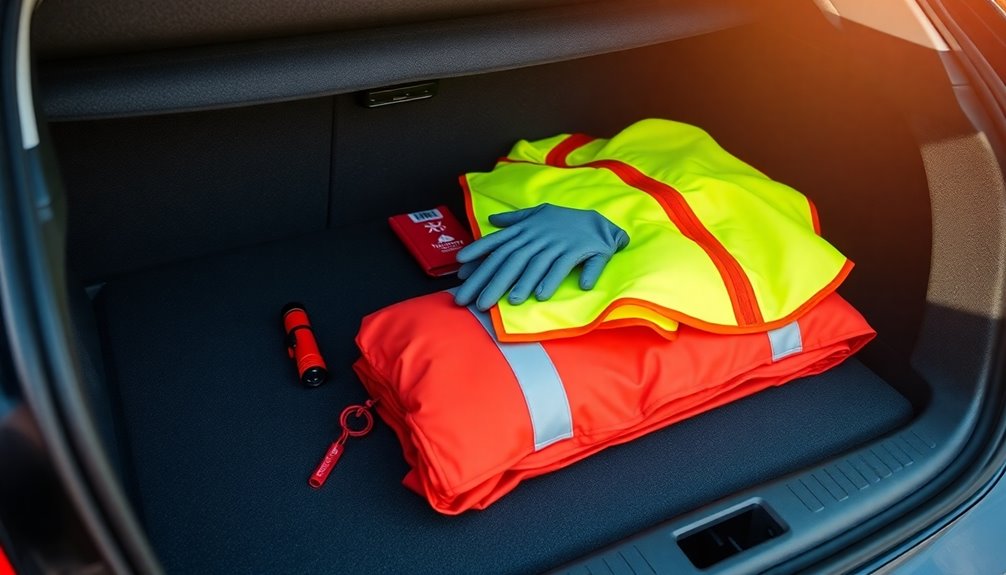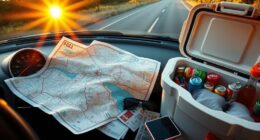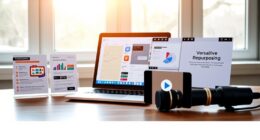To prepare for emergencies on the road, you need to pack essential supplies like a first aid kit, roadside assistance tools, and personal safety items. Regular vehicle maintenance, such as checking oil and tire pressure, can prevent breakdowns. Also, ensure you have reliable communication tools and keep your emergency contact information updated. Familiarizing yourself with common scenarios and local resources can be crucial. There's plenty more to consider for a well-rounded emergency plan.
Key Takeaways
- Assemble a well-stocked emergency kit including a first aid kit, roadside assistance tools, and personal safety items for unexpected situations.
- Regularly maintain your vehicle by checking fluids, tire pressure, and brakes to reduce the risk of breakdowns.
- Stay informed about weather conditions and plan alternative routes to avoid dangerous travel scenarios.
- Ensure reliable communication tools are on hand, such as a charged phone and portable charger, for emergencies.
- Set aside an emergency fund specifically for travel-related expenses to cover unforeseen costs while on the road.
Essential Emergency Supplies for Your Vehicle
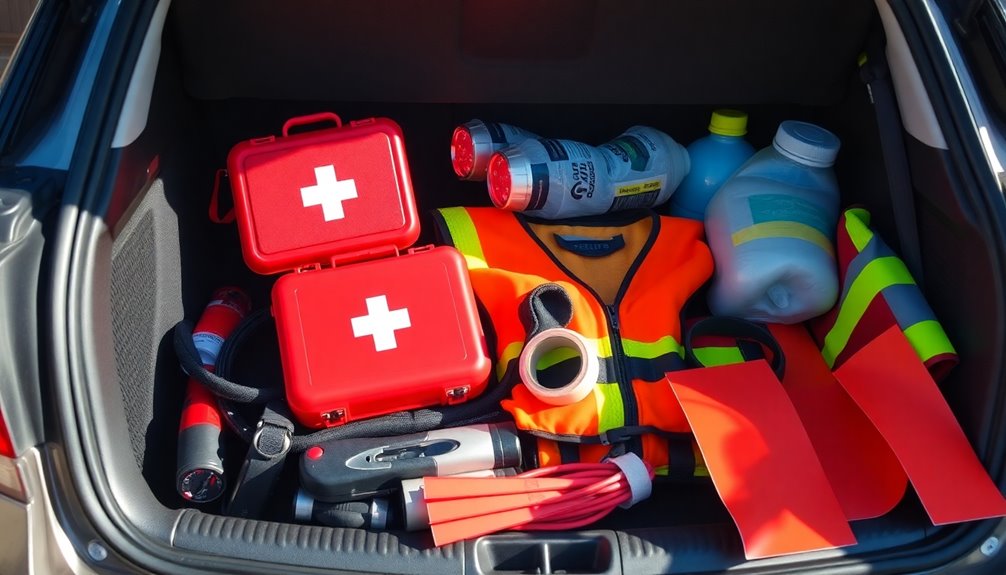
When you're on the road, having essential emergency supplies in your vehicle can make all the difference in a crisis.
Start with a well-stocked first aid kit containing bandages, antiseptic wipes, pain relievers, heavy-duty gloves, and scissors. These items help you manage injuries effectively.
Next, include roadside assistance tools like a spare tire, jack, and lug wrench for flat tires, along with jumper cables for dead batteries. Additionally, ensure that you have a properly inflated spare tire to avoid further complications in case of a flat.
Don't forget safety equipment like reflective warning triangles, a flashlight with extra batteries, and a reflective safety vest to enhance visibility.
Lastly, add a multi-tool for basic repairs and keep drinking water and snacks handy to sustain you during unexpected delays.
Being prepared ensures you're ready for anything on the road.
Vehicle Maintenance Tips to Prevent Breakdowns
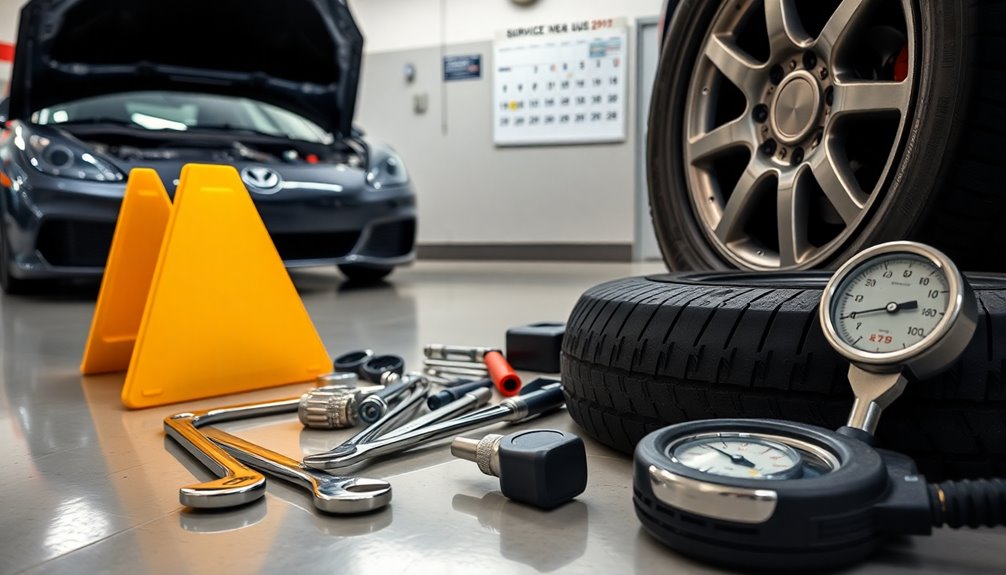
To keep your vehicle running smoothly and avoid unexpected breakdowns, regular maintenance is essential.
Start with fluid checks; change your oil every 3,000 to 5,000 miles, and ensure coolant, brake, power steering, and transmission fluids are at proper levels. Regular oil changes are crucial to prevent overheating and engine wear.
Regularly check your tire pressure, rotate tires every 5,000 to 10,000 miles, and inspect tread depth for safety.
Maintain your battery by checking its health and cleaning terminals.
Inspect brake pads and belts frequently to catch wear early.
Lastly, always carry a spare tire and know how to change it.
Importance of Communication Tools During Emergencies
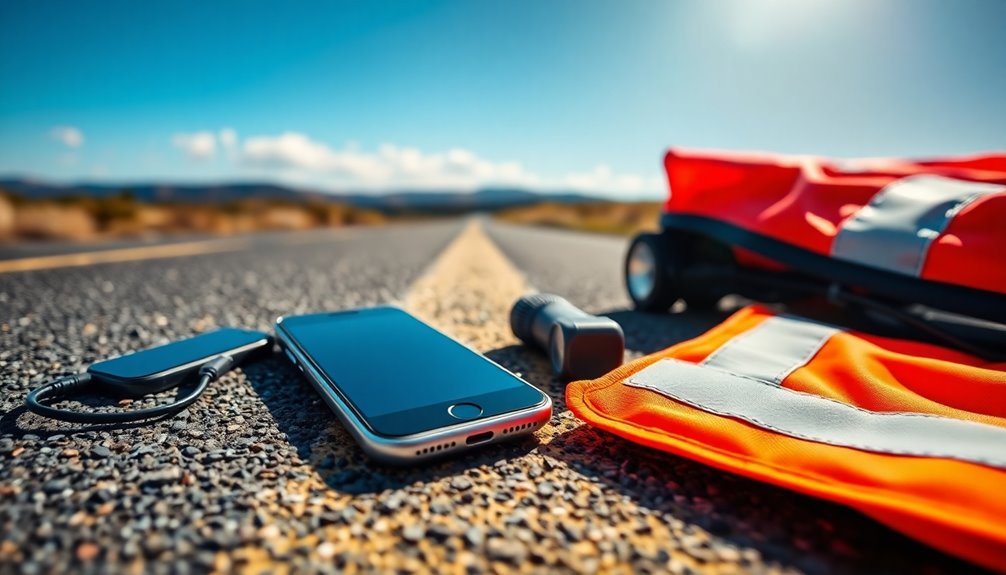
Regular vehicle maintenance helps prevent breakdowns, but even the best-prepared drivers can face emergencies on the road.
That's why reliable communication tools are essential. They ensure timely information dissemination, allowing you to respond quickly to any situation. By using interoperable systems like digital radios and satellite phones, you can coordinate effectively with first responders, even in remote areas. Modern systems utilize digital radios, which enhance the clarity and security of communications, ensuring you remain connected when it matters most.
Speed is key; rapid information exchange can save lives. Make sure these tools are accessible to everyone involved, from your response team to the affected community.
Versatility matters too—using a mix of communication methods, such as cellular networks and social media, enhances your response flexibility, ensuring you reach everyone who needs help.
Always prioritize clear and timely messaging.
Personal Safety Items to Include in Your Emergency Kit
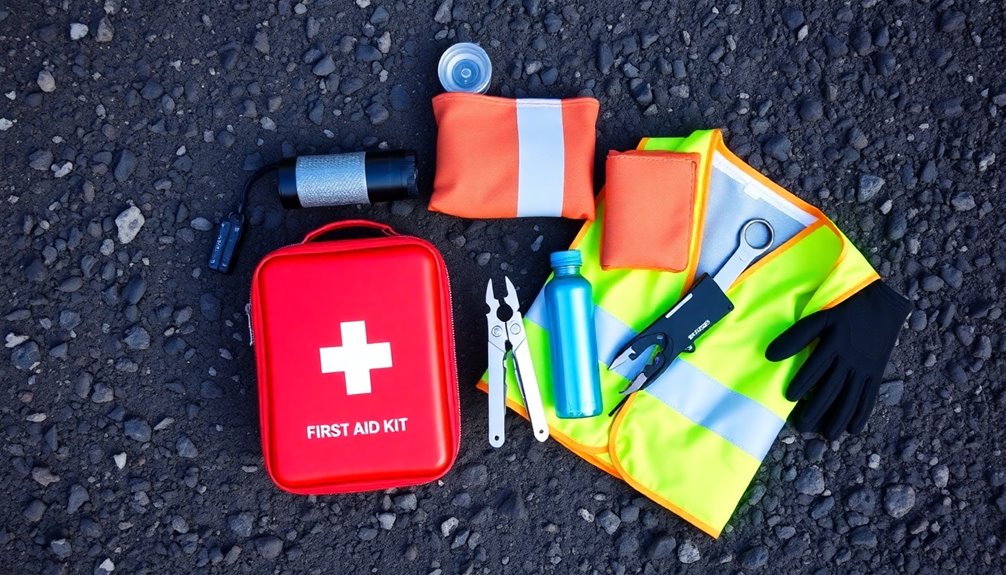
As emergencies can strike unexpectedly, having a well-stocked emergency kit is crucial for your personal safety on the road.
Start with a first aid kit to treat minor injuries like cuts and burns. Include a blanket or emergency foil blanket for warmth in cold weather. Reflective warning triangles and road flares will increase your visibility, helping others spot you. Additionally, having a road safety kit can significantly enhance journey safety and prepare you for various roadside emergencies.
A flashlight with extra batteries ensures you can see in the dark, while duct tape is handy for quick fixes. Don't forget jumper cables or a portable jump starter for a dead battery, and keep a tire pressure gauge to maintain proper inflation.
These items can make a significant difference in ensuring your safety during roadside emergencies.
Planning for Different Emergency Scenarios
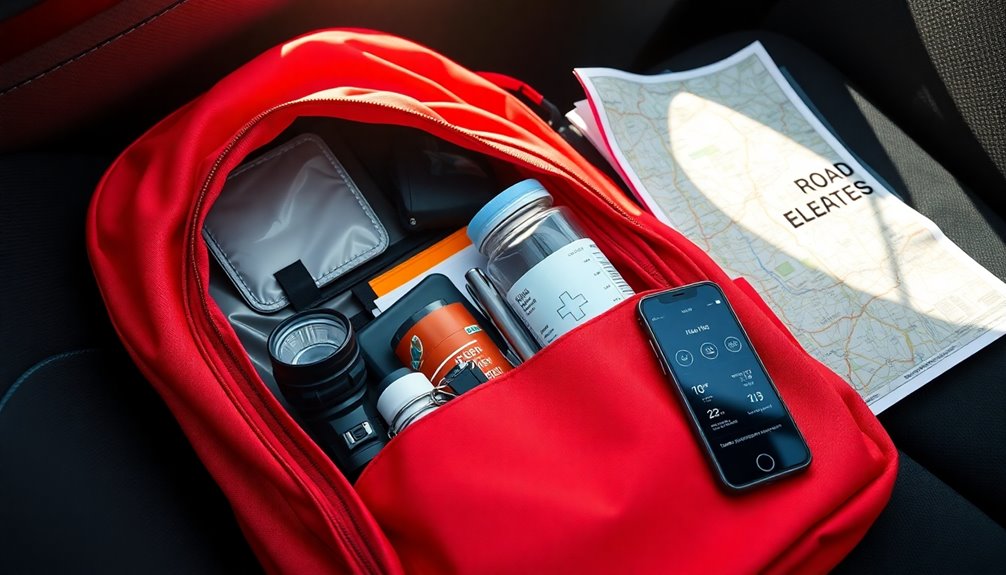
Having the right personal safety items in your emergency kit is just the start of being prepared for unexpected situations on the road. Regular vehicle inspections help prevent breakdowns, ensuring your tires, brakes, and fluids are in check. Additionally, it's important to include common emergency scenarios relevant to your travel routes in your planning. Carry essential tools like jumper cables, a spare tire, and a flashlight to handle common issues. Consider a roadside assistance plan for quick help when needed. Stay aware of weather forecasts to avoid hazardous driving conditions, and know alternative routes to navigate around accidents.
In natural disasters, familiarize yourself with evacuation routes and local shelters. Keep emergency supplies like food, water, and a first aid kit in your vehicle for added safety. Regularly updating your kit ensures it contains usable and fresh supplies that can make all the difference in an emergency. Always be ready for whatever comes your way.
Keeping Your Emergency Contact Information Updated
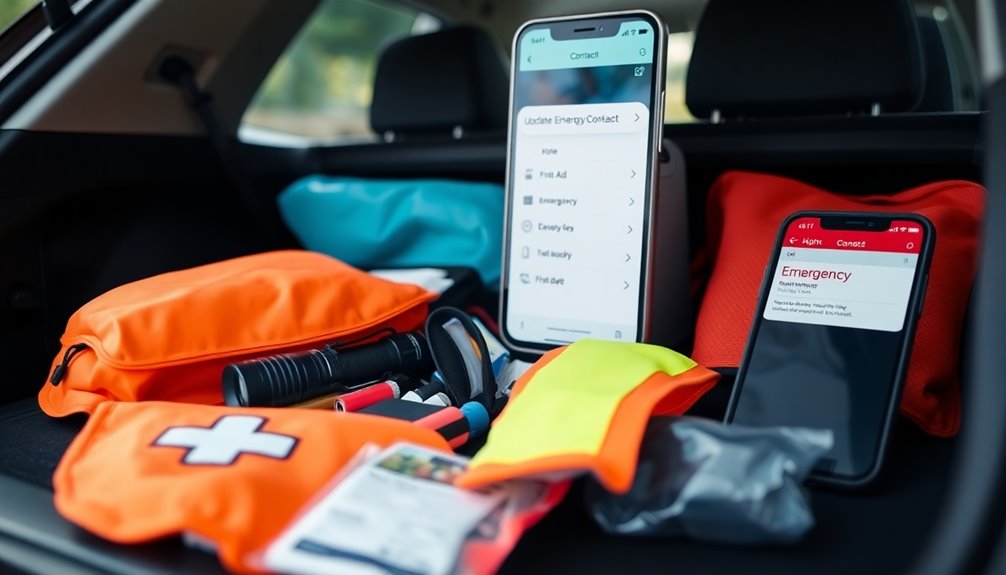
Keeping your emergency contact information updated is essential for ensuring quick assistance when you need it most.
Make sure you include contacts for roadside assistance, insurance providers, and personal emergency contacts. Store this information in a way that's easily accessible, whether it's physical cards in your wallet or digital notes on your phone. Additionally, consider including first aid supplies in your emergency kit to be better prepared for any medical needs that may arise.
Regularly review and update these details to reflect any changes, ensuring all information remains current. Don't forget to share your emergency contacts with family members or travel companions.
Before hitting the road, verify that all your emergency contact information is accurate and included in your vehicle's emergency kit. This proactive approach can make all the difference in an emergency situation.
Navigational Aids for When Technology Fails
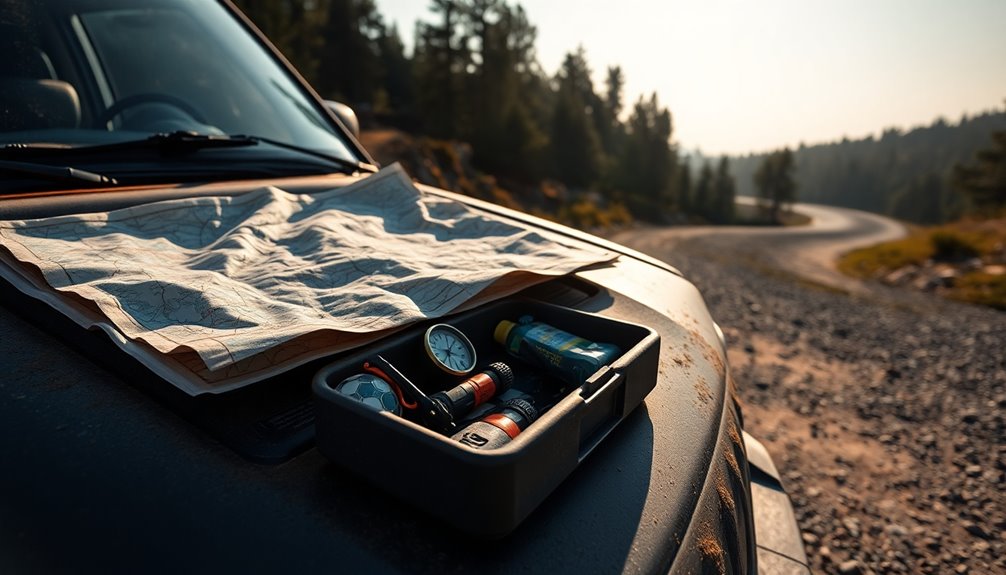
What do you do when your GPS fails or your smartphone loses signal in the middle of nowhere?
First, pull out a paper map. Familiarize yourself with the area and plan your route using visible landmarks. A compass can help you maintain your direction, especially if you know your starting point. Additionally, having knowledge of swift response can help you identify the best routes to take in case of an emergency.
If you're near water, look for navigational aids like buoys or markers. Remember, natural features can also guide you—mountains, rivers, and buildings serve as excellent reference points.
If you're stuck, consider star navigation; the North Star can guide you at night. Always stay calm and assess your surroundings.
Developing an Emergency Fund for Unexpected Situations
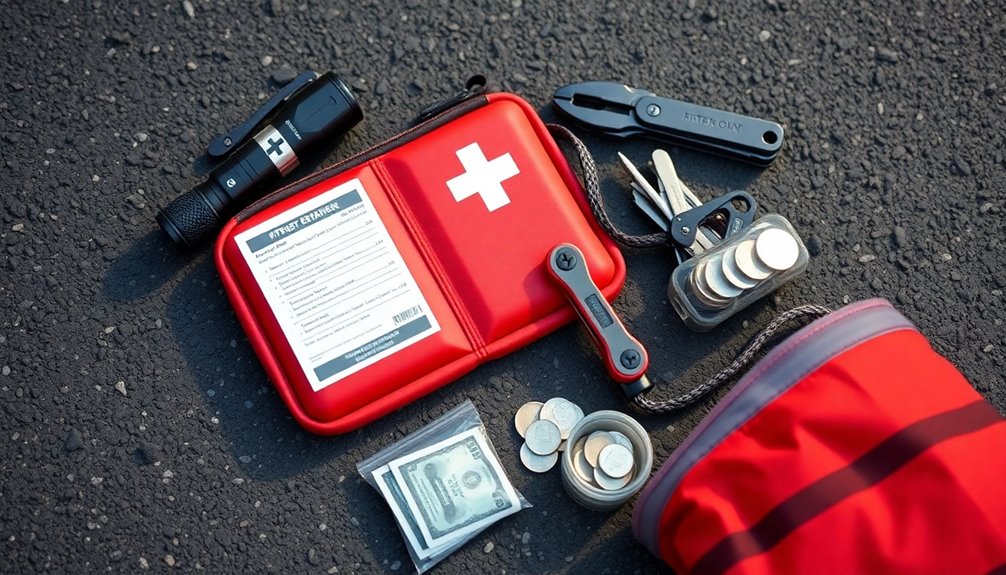
While unexpected situations like car breakdowns or medical emergencies can be stressful, having an emergency fund can make a significant difference. This fund provides financial stability, reducing the need for loans and keeping debt at bay. Knowing you have a safety net offers peace of mind during uncertain times. Start by budgeting a portion of your income specifically for savings; consider setting up automatic transfers to make it easier. Cut unnecessary expenses to boost your savings, and explore additional income sources to enhance your financial resilience. Remember, maintaining discipline is crucial—don't dip into your fund for non-emergencies. Only 41% of Americans would use savings for major unexpected expenses, highlighting the importance of having a solid emergency fund. With a solid emergency fund, you'll feel more prepared for whatever challenges the road may throw your way.
Frequently Asked Questions
What Should I Do if I Get Stranded Overnight?
If you get stranded overnight, stay calm and assess your situation.
Position your vehicle safely, turn on your hazard lights, and stay inside to conserve body heat.
Use your emergency kit for warmth, food, and water.
If you have a cellphone, call for help, but conserve battery by texting instead.
Signal for help with flares or a bright cloth.
Keep moving your extremities to prevent frostbite while waiting for assistance.
How Can I Protect My Vehicle From Theft During Emergencies?
To protect your vehicle from theft during emergencies, always lock your doors and close windows when you park.
Remove your keys from the ignition and keep them secure.
Park in well-lit areas and avoid leaving valuables in sight.
Consider installing a steering wheel lock or an audible alarm for extra security.
If your vehicle gets stolen, contact the police right away and file a report to increase your chances of recovery.
What Are the Legal Requirements for Emergency Supplies in My State?
To find the legal requirements for emergency supplies in your state, check your state's regulations or transportation department guidelines.
While federal laws don't specify exact supplies for personal vehicles, state laws may suggest items like first aid kits or extra water.
It's smart to stay informed about any local recommendations or mandates, especially during emergencies, as requirements can change based on specific situations or declarations.
Always prioritize safety when traveling.
How Often Should I Update My Emergency Contact List?
You might think once a year is enough, but life changes constantly, and your emergency contact list needs to keep pace.
Whenever someone's contact details change or significant events occur, update your list immediately. Accuracy is crucial; it could make a difference in urgent situations.
Make it accessible and easy for yourself and others to find. Regular reminders help keep everyone informed about the importance of maintaining up-to-date information.
What Should I Include for Pets in an Emergency Kit?
When assembling an emergency kit for your pets, make sure you include essential supplies like a two-week supply of bottled water and pet food in waterproof containers.
Don't forget collapsible bowls, a manual can opener, and feeding instructions.
For safety, include a leash, collar, ID tags, and recent photos of your pets.
Also, pack a pet first aid kit, blankets, toys, and any necessary medications to keep them comfortable and safe.
Conclusion
Being prepared for emergencies on the road can make all the difference. Did you know that nearly 70% of drivers experience a breakdown at some point? Imagine being stranded without the right supplies or plans in place. By equipping your vehicle with essential tools and maintaining it regularly, you can navigate unexpected situations with confidence. Remember to keep your emergency contacts updated and have a solid plan for different scenarios. Don't wait until it's too late—start preparing today!

